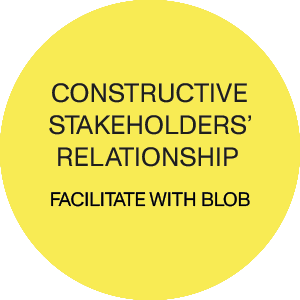Constructive stakeholders’ relationships involve the establishment and maintenance of positive and mutually beneficial connections with individuals or groups who have an interest or stake in an organization.
It entails open communication, active engagement and collaboration to address common goals and concerns.
Constructive stakeholders’ approach fosters trust, transparency and a shared understanding, contributing to the long-term success and sustainability of the organization.
Personalized Progress Disclaimer. Embarking on a journey to enhance your professional presence can feel like a significant undertaking. We want to assure you that our approach is tailored to your pace, ensuring a smooth and comfortable experience. Our collaborative process begins with an exploration of your goals, and together, we navigate the learning curve at a speed that suits you. Your progress is the compass, and we are here to guide you, ensuring a relaxed and uplifting journey. You can trust that every step is orchestrated to align with your comfort, ensuring a positive and manageable path towards achieving your business aspirations.

By implementing these strategies, we can help a client facilitate constructive stakeholder relationships, fostering trust, loyalty and mutual understanding. The focus on clear communication, engagement initiatives, conflict resolution and ongoing evaluation contributes to the success of stakeholder relationship-building efforts:
STAKEHOLDER ANALYSIS:
- Identify Key Stakeholders: working with the client to identify and categorize key stakeholders, including customers, employees, investors, regulators, suppliers and the community
- Understand Stakeholder Needs: conducting thorough research to understand the needs, expectations and concerns of each stakeholder group. This analysis forms the basis for tailored relationship-building strategies
COMMUNICATION STRATEGIES:
- Develop Clear Messaging: assisting the client in developing clear and consistent messaging that addresses the interests of different stakeholder groups. Ensure that messages align with the client’s values and goals
- Multichannel Communication: implementing a multichannel communication strategy to reach diverse stakeholders. This may include traditional media, social media, newsletters, direct communications and other relevant channels
- Proactive Communication: encouraging the client to communicate proactively, providing updates on important developments, addressing concerns preemptively and showcasing achievements
RELATIONSHIP-BUILDING INITIATIVES:
- Stakeholder Engagement Events: organizing stakeholder engagement events such as forums, town hall meetings and focus groups. These provide opportunities for direct interaction and feedback
- Community Involvement Programs: developing and supporting community involvement programs, demonstrating the client’s commitment to social responsibility and fostering positive relationships with the community
- Customer Feedback Mechanisms: implementing effective customer feedback mechanisms, such as surveys, reviews and customer service channels, to understand and address customer needs and concerns
- Employee Engagement Programs: assisting in creating employee engagement programs that promote a positive workplace culture, open communication and a sense of belonging
- Investor Relations Support: providing support in managing investor relations, including transparent financial reporting, regular updates and addressing investor inquiries.
CONFLICT RESOLUTION:
- Develop Crisis Communication Plans: working with the client to develop crisis communication plans, ensuring that the client is prepared to address and mitigate potential issues that may arise
- Mediation and Conflict Resolution: providing mediation support and conflict resolution strategies for managing disputes or disagreements with stakeholders. Fostering open dialogue to find mutually beneficial solutions
PERFORMANCE MEASUREMENT:
- Stakeholder Satisfaction Surveys: conducting stakeholder satisfaction surveys to gauge the level of satisfaction and identify areas for improvement. Using the feedback to enhance relationship-building strategies
- Key Performance Indicators (KPIs): defining and tracking key performance indicators related to stakeholder relationships. This could include measures of customer satisfaction, employee engagement and community impact
TECHNOLOGY INTEGRATION:
- CRM Systems: implementing Customer Relationship Management (CRM) systems to streamline communication and information management for various stakeholder groups
- Social Listening Tools: utilizing social listening tools to monitor online conversations and sentiment related to the client. Address issues and capitalize on positive feedback in real-time
TRAINING AND CAPACITY BUILDING:
- Stakeholder Engagement Training: providing training to client teams on effective stakeholder engagement, including communication skills, conflict resolution and relationship-building techniques
- Crisis Communication Drills: conducting crisis communication drills to ensure that the client’s team is well-prepared to handle challenging situations and communicate effectively during crises
REPORTING AND TRANSPARENCY:
- Transparent Reporting: promoting transparency through regular reporting on key initiatives, performance and the impact of the client’s activities on various stakeholders
- Sustainability Reporting: supporting the development and communication of sustainability reports, showcasing the client’s commitment to environmental, social and governance (ESG) principles

Pricing. Our pricing structure is designed with modularity in mind, ensuring that you only pay for the services you require, allowing for flexibility and customization. For each task you may decide to delegate to us there is a prewritten full-service list. This list consists of basic must do services, extent of available optional added services and suggestion of optional added third party services. During our task related Initial Chat, in a direct conversation with the client, we choose a customized list of services as per clients’ needs and circumstances. To accommodate different difficulty levels, we introduce an index for difficulty. The basic price is multiplied by this index to calculate the price for a task at any difficulty level, ensuring a fair and flexible pricing model that accurately reflects the complexity of the services provided. The level is argumented and agreed upon during the task related Initial Chat. With these inputs we then prepare and deliver to client our exact offer. For client’s information and potential budget range idea we have provided, for each task, a task price list as .pdf file with relevant details disclosed.

